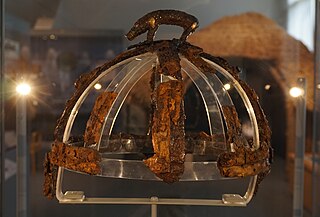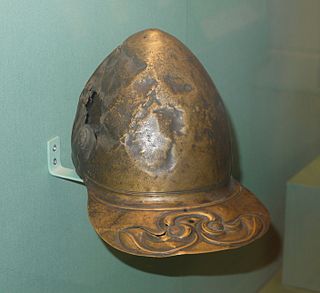
Sutton Hoo is the site of two Anglo-Saxon cemeteries dating from the 6th to 7th centuries near Woodbridge, Suffolk, England. Archaeologists have been excavating the area since 1938, when an undisturbed ship burial containing a wealth of Anglo-Saxon artifacts was discovered. The site is important in establishing the history of the Anglo-Saxon kingdom of East Anglia as well as illuminating the Anglo-Saxons during a period which lacks historical documentation.

Below are notable events in archaeology that occurred in 1877.

The Benty Grange helmet is an Anglo-Saxon boar-crested helmet from the seventh century AD. It was excavated by Thomas Bateman in 1848 from a tumulus at the Benty Grange farm in Monyash in western Derbyshire. The grave had probably been looted by the time of Bateman's excavation, but still contained other high-status objects suggestive of a richly furnished burial, such as the fragmentary remains of a hanging bowl. The helmet is displayed at Sheffield's Weston Park Museum, which purchased it from Bateman's estate in 1893.

The Coolus helmet was a type of ancient Celtic and Roman helmet popular in the 1st century BCE. It was typically made in bronze or brass and, like the Montefortino type with which it co-existed, was a descendant of Celtic helmet types. The explanation of the choice to use bronze can be attributed to the type of warfare that the helmet was used for; also the cultural affinities have influence on why the helmet was made the way that it was. Within a long process of evolution, Roman military armor for the head developed from early pre-Roman helmets. Rome itself had no proper tradition of such objects, as most of the soldiers of the Early Republic made use of helmets produced by the Etruscans, whose craftsmen were known for their ability to make vessels.

The Coppergate Helmet is an eighth-century Anglo-Saxon helmet found in York, England. It was discovered in May 1982 during excavations for the Jorvik Viking Centre at the bottom of a pit that is thought to have once been a well.

The Sutton Hoo helmet is a decorated Anglo-Saxon helmet found during a 1939 excavation of the Sutton Hoo ship-burial. It was buried around the years c. 620–625 AD and is widely associated with an Anglo-Saxon leader, King Rædwald of East Anglia; its elaborate decoration may have given it a secondary function akin to a crown. The helmet was both a functional piece of armour and a decorative piece of metalwork. An iconic object from an archaeological find hailed as the "British Tutankhamen", it has become a symbol of the Early Middle Ages, "of Archaeology in general", and of England.

The Ormside Bowl is an Anglo-Saxon double-bowl in gilded silver and bronze, with glass, perhaps Northumbrian, dating from the mid-8th century which was found in 1823, possibly buried next to a Viking warrior in Great Ormside, Cumbria, though the circumstances of the find were not well recorded. If so, the bowl was probably looted from York by the warrior before being buried with him on his death. The bowl is one of the finest pieces of Anglo-Saxon silverwork found in England.

The Waterloo Helmet is a pre-Roman Celtic bronze ceremonial horned helmet with repoussé decoration in the La Tène style, dating to circa 150–50 BC, that was found in 1868 in the River Thames by Waterloo Bridge in London, England. It is now on display at the British Museum in London.

The Meyrick Helmet is an Iron Age bronze peaked helmet, with La Tène style decoration, that is held at the British Museum in London. It is one of only four Iron Age helmets to have been discovered in Britain, the other three being the more famous Waterloo Helmet, the Canterbury Helmet and the North Bersted Warrior helmet. Unlike the Waterloo Helmet, which bears two cone-shaped horns, the Meyrick Helmet is hornless and appears to be based on a Roman model. Vincent Megaw, emeritus professor of archaeology at the University of Leicester, has conjectured that the helmet may have belonged to a British auxiliary fighting in the Roman army during the campaigns against the Brigantes in AD 71–74.

The Wandsworth Shield is a circular bronze Iron Age shield boss or mount decorated in La Tène style which was found in the River Thames at Wandsworth in London sometime before 1849. Another incomplete bronze shield mount, sometimes called the Wandsworth Mask Shield was found at the same time. Both shield mounts are now held at the British Museum. The bold repoussé decoration on the Wandsworth Shield, comprising two birds with outstretched wings and long trailing tail feathers, has led Barry Cunliffe, Emeritus Professor of European Archaeology at the University of Oxford, to consider the shield to be "among the masterpieces of British Celtic art".

The Pioneer Helmet is an Anglo-Saxon boar-crested helmet from the late seventh century found in Wollaston, Northamptonshire, United Kingdom. It was discovered during a March 1997 excavation before the land was to be mined for gravel and was part of the grave of a young man. Other objects in the grave, such as a hanging bowl and a pattern welded sword, suggest that it was the burial mound of a high-status warrior.

The Guisborough Helmet is a Roman cavalry bronze helmet found in 1864 near Guisborough in the North Riding of Yorkshire, England. It was originally fitted with a pair of protective cheek-pieces, which have not survived; the holes by which they were attached can be seen in front of the helmet's ear guards. It is lavishly decorated with incised, punched and embossed figures, indicating that it was probably used for displays or cavalry tournaments, though it may well have been intended to be worn in battle as well. The helmet was found in what appears to have been a carefully arranged deposition in a bed of gravel, distant from any known Roman sites. After it was recovered during road works it was donated to the British Museum in London, where it was restored and is currently on display.

The Nijmegen Helmet is a Roman cavalry sports helmet from the first or second century AD. It was found around 1915 in a gravel bed on the left bank of the Waal river, near the Dutch city of Nijmegen. The helmet would have been worn by the élite Roman cavalry. The head portion of the helmet is made of iron, while the mask and diadem are of bronze or brass. The helmet provides neck protection via a projecting rim overlaid with a thin bronze covering plated with silver. The diadem features two male and three female figures.

The Shorwell helmet is an Anglo-Saxon helmet from the early to mid-sixth century AD found near Shorwell on the Isle of Wight in southern England. It was one of the grave goods of a high-status Anglo-Saxon warrior, and was found with other objects such as a pattern-welded sword and hanging bowl. One of only six known Anglo-Saxon helmets, alongside those found at Benty Grange (1848), Sutton Hoo (1939), Coppergate (1982), Wollaston (1997), and Staffordshire (2009), it is the sole example to derive from the continental Frankish style rather than the contemporaneous Northern "crested helmets" used in England and Scandinavia.

The Agris Helmet is a ceremonial Celtic helmet from c. 350 BC that was found in a cave near Agris, Charente, France, in 1981. It is a masterpiece of Celtic art, and would probably have been used for display rather than worn in battle. The helmet consists of an iron cap completely covered with bands of bronze. The bronze is in turn covered with unusually pure gold leaf, with embedded coral decorations attached using silver rivets. One of the cheek guards was also found and has similar materials and designs. The helmet is mostly decorated in early Celtic patterns but there are later Celtic motifs and signs of Greek influence. The quality of the gold indicates that the helmet may well have been made locally in the Atlantic region.

Herbert James Maryon was an English sculptor, conservator, goldsmith, archaeologist and authority on ancient metalwork. Maryon practiced and taught sculpture until retiring in 1939, then worked as a conservator with the British Museum from 1944 to 1961. He is best known for his work on the Sutton Hoo ship-burial, which led to his appointment as an Officer of the Order of the British Empire.

Elizabeth Grayson Hartley, was an American archaeologist and curator. She spent most of her career as the Keeper of Archaeology at the Yorkshire Museum in York.

The Guilden Morden boar is a sixth- or seventh-century Anglo-Saxon copper alloy figure of a boar that may have once served as the crest of a helmet. It was found around 1864 or 1865 in a grave in Guilden Morden, a village in the eastern English county of Cambridgeshire. There the boar attended a skeleton with other objects, including a small earthenware bead with an incised pattern, although the boar is all that now remains. Herbert George Fordham, whose father originally discovered the boar, donated it to the British Museum in 1904; as of 2018 it was on view in room 41.

The Emesa helmet is a Roman cavalry helmet from the early first century AD. It consists of an iron head piece and face mask, the latter of which is covered in a sheet of silver and presents the individualised portrait of a face, likely its owner. Decorations, some of which are gilded, adorn the head piece. Confiscated by Syrian police soon after looters discovered it amidst a complex of tombs in the modern-day city of Homs in 1936, eventually the helmet was restored thoroughly at the British Museum, and is now in the collection of the National Museum of Damascus. It has been exhibited internationally, although as of 2017, due to the Syrian civil war, the more valuable items owned by the National Museum are hidden in underground storage.
Leslie Elizabeth Webster, is an English retired museum curator and art historian of Anglo-Saxon and Viking art. She worked from 1964 until 2007 at the British Museum, rising to Keeper, where she curated several major exhibitions, and published many works, on the Anglo-Saxons and Early Middle Ages.





















